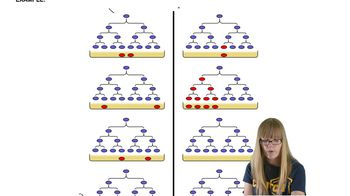Table of contents
- 1. Introduction to Genetics51m
- 2. Mendel's Laws of Inheritance3h 37m
- 3. Extensions to Mendelian Inheritance2h 41m
- 4. Genetic Mapping and Linkage2h 28m
- 5. Genetics of Bacteria and Viruses1h 21m
- 6. Chromosomal Variation1h 48m
- 7. DNA and Chromosome Structure56m
- 8. DNA Replication1h 10m
- 9. Mitosis and Meiosis1h 34m
- 10. Transcription1h 0m
- 11. Translation58m
- 12. Gene Regulation in Prokaryotes1h 19m
- 13. Gene Regulation in Eukaryotes44m
- 14. Genetic Control of Development44m
- 15. Genomes and Genomics1h 50m
- 16. Transposable Elements47m
- 17. Mutation, Repair, and Recombination1h 6m
- 18. Molecular Genetic Tools19m
- 19. Cancer Genetics29m
- 20. Quantitative Genetics1h 26m
- 21. Population Genetics50m
- 22. Evolutionary Genetics29m
17. Mutation, Repair, and Recombination
Spontaneous Mutations
Problem 1
Textbook Question
In this chapter, we focused on how gene mutations arise and how cells repair DNA damage. At the same time, we found opportunities to consider the methods and reasoning by which much of this information was acquired. From the explanations given in the chapter, How do we know that DNA repair mechanisms detect and correct the majority of spontaneous and induced mutations?
 Verified step by step guidance
Verified step by step guidance1
Understand that DNA repair mechanisms are crucial for maintaining genetic stability by correcting errors that occur during DNA replication or due to environmental factors.
Recognize that experimental evidence supports the existence of DNA repair mechanisms. For example, studies using model organisms with defective repair genes show increased mutation rates, indicating the role of these genes in repair.
Consider the types of DNA repair mechanisms, such as mismatch repair, base excision repair, nucleotide excision repair, and double-strand break repair, each targeting specific types of DNA damage.
Examine how researchers use techniques like mutagenesis and genetic screens to identify and study genes involved in DNA repair pathways, providing insights into their function and efficiency.
Review the impact of DNA repair deficiencies in humans, such as in genetic disorders like xeroderma pigmentosum, which highlight the importance of these mechanisms in preventing mutations and maintaining genomic integrity.
Recommended similar problem, with video answer:
 Verified Solution
Verified SolutionThis video solution was recommended by our tutors as helpful for the problem above
Video duration:
1mPlay a video:
Was this helpful?
Key Concepts
Here are the essential concepts you must grasp in order to answer the question correctly.
DNA Repair Mechanisms
DNA repair mechanisms are cellular processes that identify and correct damage to the DNA molecules that encode an organism's genome. These mechanisms include various pathways such as base excision repair, nucleotide excision repair, and mismatch repair, which work to fix different types of DNA lesions. Understanding these processes is crucial for comprehending how cells maintain genetic integrity and prevent mutations.
Recommended video:
Guided course

Repair Pathways
Spontaneous and Induced Mutations
Spontaneous mutations occur naturally during DNA replication or due to internal cellular processes, while induced mutations result from external factors such as radiation or chemical exposure. Both types of mutations can lead to changes in the genetic code, potentially affecting protein function and cellular behavior. Recognizing the sources and types of mutations helps in understanding the necessity and effectiveness of DNA repair mechanisms.
Recommended video:
Guided course

Spontaneous Mutations
Experimental Evidence for DNA Repair
Experimental evidence for the effectiveness of DNA repair mechanisms comes from various studies, including those using mutant strains of organisms that lack specific repair pathways. These studies often show increased mutation rates in these mutants compared to wild-type organisms, demonstrating the role of repair systems in correcting DNA damage. Additionally, techniques such as sequencing and molecular assays provide insights into the frequency and types of mutations that repair mechanisms can address.
Recommended video:
Guided course

Repair Pathways

 9:52m
9:52mWatch next
Master Spontaneous Mutations with a bite sized video explanation from Kylia Goodner
Start learningRelated Videos
Related Practice

